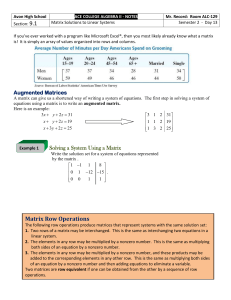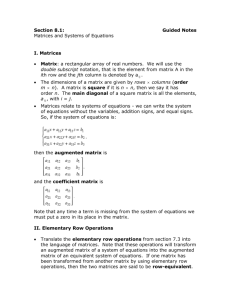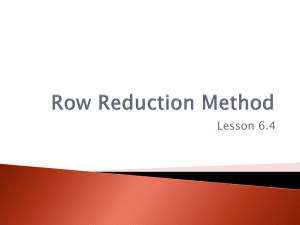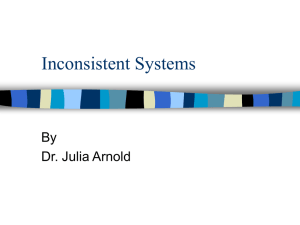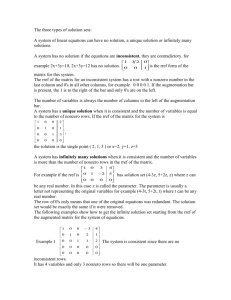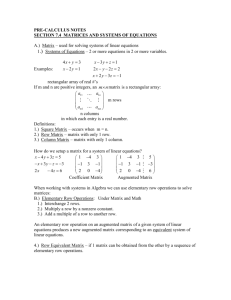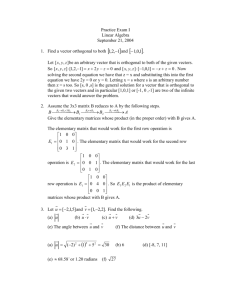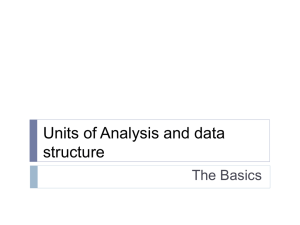Sections 1.1 & 1.2
advertisement
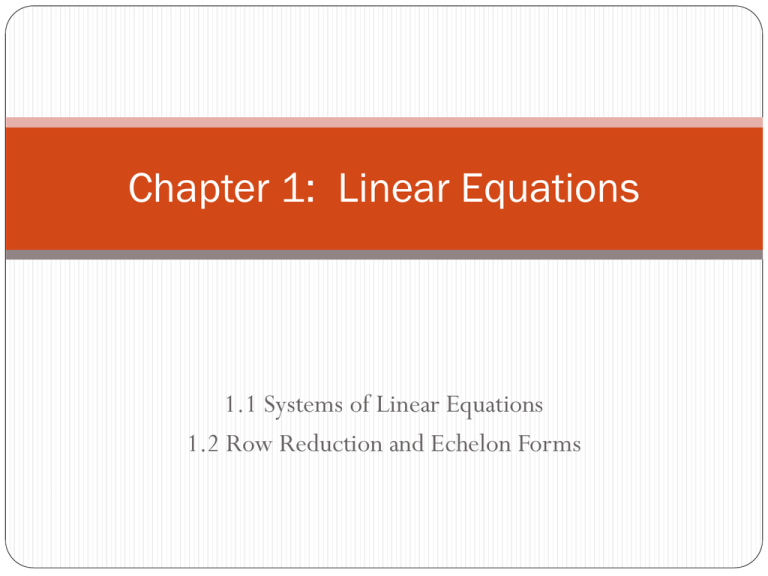
Chapter 1: Linear Equations
1.1 Systems of Linear Equations
1.2 Row Reduction and Echelon Forms
Solve each system of equations
x y 5
#1.
2 x y 1
x 2y 5
#2.
3x 6 y 3
x 2y z 5
# 3. 3x y z 3
x 3y 1
a1x1 a2 x2 an xn b
where a1,, an , b are real or complexnumbers
Linear Equation:
Example: y 2 x 5
System of linear equations: A collection of one
or more linear equations involving the same variables
2 x1 17 x3 5
Example :
x1 x2 x3 0
•Solution Set
The set of all possible solutions to a
linear system.
•Two linear systems are called equivalent,
if they have the same solution set.
4 x1 2 x2 6
2 x1 x2 3
Ex :
&
are equivalent.
2 x1 4 x2 0
x1 2 x2 0
Matrix Notation
Any linear system can be written as a matrix (rectangular
array) whose entries are the coefficients.
The size of a matrix tells how many rows and columns it
has. (Ex: This is a 2x4 matrix.)
2 0 17 5
1 1 1 0
2 x1 17x3 5
For the linear system:
x1 x2 x3 0
The matrix
2 0 17
1 1 1
is called the
coefficient matrix, and the matrix
2 0 17 5
1 1 1 0
is called the augmented matrix.
Algorithmic Procedure for Solving a Linear
System
Basic idea: Replace one system with an equivalent
system that is easier to solve.
Example: Solve the following system:
4 x1 2 x2 6
2 x1 4 x2 0
4 x1 2 x2 6
/2
/(-2)
2
x
4
x
0
1
2
4 2 6
2 4 0
2 x1 x2 3
x1 2 x2 0
2 1 3
1 2 0
x1 2 x2 0
+)2 x1 x2 3
x1 2 x2 0
3 x2 3
x1 2 x2 0
x2 1
x1
2
x2 1
*(-2)
/3
1 2 0
2 1 3
1 2 0
0
3
3
1 2 0
0 1 1
1 0 2
0 1 1
R1*(1/2) → R1
R2*(-1/2) → R2
R1 ↔ R2
-2*R1+R2 → R2
R2*(1/3) → R2
2*R2+R1 → R1
Elementary Row Operations (Theorem 1.1.1)
Each of the following operations, performed on any linear system, produce
a new linear system that is equivalent to the original.
1. Interchange two rows.
2. Add a multiple of one row to another row.
3. Multiply a row by any nonzero constant.
R1
2
1
0
5
4
6
R2
4
1
3
3
1
2
0
(-2)R1+R2
4
5
6
R2
R2/(-3)
R2
3
1 4 3
1 4 3
2
3
4 0 3 2 0 1 2 / 3
0 6 3
0 6 3
3
Gauss-Jordan elimination method to solve a system of
linear equations
2 x1 5 x2 4 x3 4
Solve x1 4 x2 3 x3 1
x 3x 2 x 5
2
3
1
4
2 5
1 4
3
1 3 2
4
1
5
Augmented matrix
x1 0 x2 0 x3 3
0 x1 x2 0 x3 2
0 x 0 x x 2
2
3
1
Elementary
Row
Operations
1 0 0
0 1 0
0 0 1
x1 3
x2 2
x 2
3
3
2
2
Reduced row-echelon form
Practice with Elementary Row Operations
4
2 5
1 4
3
1 3 2
4
1
5
3
1 4
0 3 2
1 3 2
1
2
5
3
1 4
2 5
4
1 3 2
1
4
5
3
1 4
0 3 2
0 7 5
1
2
4
3
1 4
0 3 2
1 3 2
1
2
5
3
1 4
0 1 2 / 3
0 7
5
2 / 3
4
1
Practice with Elementary Row Operations
3
1 4
0 1 2 / 3
0 7
5
3
1 4
0 1 2 / 3
0 0 1 / 3
3
1 4
0 1 2 / 3
0 0
1
2 / 3
4
1
2 / 3
2 / 3
1
2 / 3
2
1
3
1 4
0 1 2 / 3
0 0
1
2 / 3
2
1 0 1 / 3
0 1 2 / 3
0 0
1
11/ 3
2 / 3
2
1 0 1 / 3
0 1 0
0 0
1
1
11/ 3
2
2
Practice with Elementary Row Operations
1 0 1 / 3
0 1 0
0 0
1
1 0 0
0 1 0
0 0 1
11/ 3
2
2
3
2
2
Gauss-Jordan elimination method to solve a system of
linear equations
2 x1 5 x2 4 x3 4
Solve x1 4 x2 3 x3 1
x 3x 2 x 5
2
3
1
4
2 5
1 4
3
1 3 2
4
1
5
Augmented matrix
x1 0 x2 0 x3 3
0 x1 x2 0 x3 2
0 x 0 x x 2
2
3
1
Elementary
Row
Operations
1 0 0
0 1 0
0 0 1
x1 3
x2 2
x 2
3
3
2
2
Reduced row-echelon form
Definition. A matrix is in reduced row-echelon form if it has the
following four properties:
1. The leftmost nonzero entry in each row is 1. (If the row is not
all zeros, this entry is called the leading 1.)
2. Each leading 1 is the only nonzero entry in its column.
3. Each leading 1 of a row is in a column to the right of the
leading 1 of the row above it.
4. All nonzero rows are above any rows of all zeros.
Word Problems
Example. A certain crazed zoologist is raising experimental
animals on a reserve near a toxic waste dump. There are four
kinds of animals:
Neon dogs have one head, two tails, four eyes and four legs.
Headless cats have no head, one tail, no eyes and four legs.
Killer ducks have two heads, no tail, four eyes and two legs.
Hopping cows have one head, one tail, two eyes and one leg.
An investigator finds in the inventory book that there are 25
heads, 24 tails, 60 eyes and 72 legs on the reserve. How
many of each kind of animal are there?
Existence and Uniqueness
Is the system consistent; that is, does at least one solution exist?
If a solution exists, is it the only one; that is, is the solution
unique?
Find the solution set of each of the following:
2 x1 x2 3
2 x1 x2 0
No solutions
Solution set: { }
Inconsistent
2 x1 x2 3
x1 2 x2 0
Unique
Solution set: {(1, 2)}
Consistent
2 x1 x2 3
4 x1 2 x2 6
Infinitely many solutions.
1
3
Solution Set: x1, x 2 : x1 x 2 , x 2 is free
2
2
A linear system has one of the following:
No solutions, or
Exactly one solution, or
Infinitely many solutions.
Practice: Writing a solution set
2a
a
2b
b
c
0
c
c 2d
1
3

